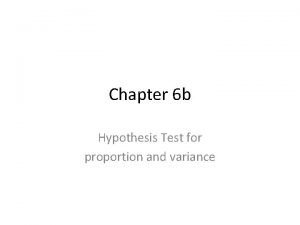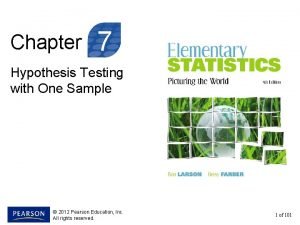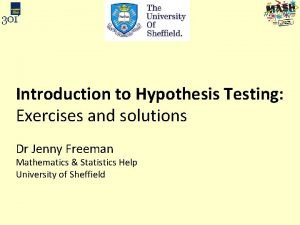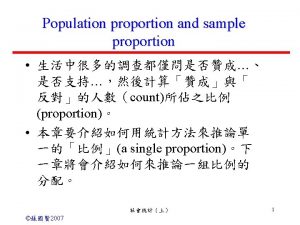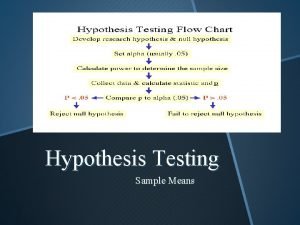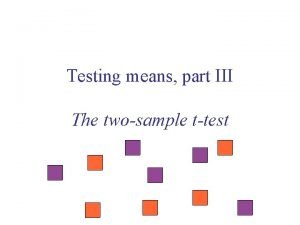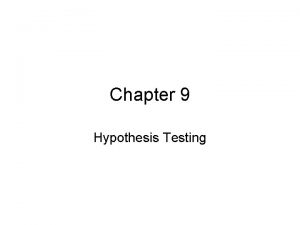Hypothesis Testing on Sample Proportion Onesample and TwoSample








- Slides: 8

Hypothesis Testing on Sample Proportion One-sample and Two-Sample Proportions

Test about the Population Proportion - “p” Test-statistic: ^ - p 0 p ______ z= p 0 (1 -p 0) n √ Ho: p = p 0 (compute the z-statistic)

Example: Le. Roy, a starting player for a major college basketball team, made only 40% of his free throws last season. During the summer, he worked on developing a softer shot in hopes of improving his free throw accuracy. In the first eight games of this season, Le. Roy made 25 free throws in 40 attempts. You want to investigate whether Le. Roy’s work over the summer will result in a higher proportion of free-throw successes this season. What conclusion would you draw at the 1% significance level about Le. Roy’s free throw shooting? Po =. 40 P-hat = 25/40 n= 40

Ho: Leroy’s proportion of free throw hits is p=. 40 Ho: Leroy’s proportion of free throw hits is p>. 40 SRS: we must be willing to treat that his free throws are random Normality: Rule of Thumb #2 np≥ 10 40(. 40)≥ 10 16≥ 10 nq≥ 10 40(. 60)≥ 10 24≥ 10 Independence: One Leroy ’ s free throw is Independent sample z-test for proportion Z = 2. 90 P-val =. 0019 With a p-val =. 0019 we have enough evidence to reject the null hypothesis making the test significant at 1% significance level. Therefore Leroy has improved his

Hypothesis Testing on Sample Proportion One-sample and Two-Sample Proportions

Warm up Any Miami Heat fan or arch-rival knows the team's very large “SHAQilles heel”—the free-throw shooting of the NBA's most dominant center, Shaquille O'Neal. Over his NBA career, Shaq has made 53. 3% of his free throws. Shaquille O'Neal worked in the off-season with an assistant coach on his free-throw technique. During the first two games of the next season, Shaq made 26 out of 39 free throws. (a) Do these results provide evidence that Shaq has significantly improved his free-throw shooting? (b) Describe a Type I error and a Type II error in this situation.

P = proportion of Shaq’s successful free throw hits H 0: p = 0. 533 vs. Ha: p > 0. 533. z = 1. 67, P–value = 0. 0475. Therefore: we reject Ho and conclude that Shaq improved his free throw shot training with his coach. This makes our HT significant. Type I error: concluding that Shaq has improved his free–throwing when in fact he has not. Type II error: concluding that Shaq has not improved his free–throwing when in fact he has.

Remaining topics we need to cover: 1. 2 -sample z-statistic 2. 2 -sample t-statistic 3. Confidence interval for 2 samples 4. Comparing proportions of 2 populations 5. Significance test for combined sample proportions 6. Confidence interval for 2 proportions 7. Chi-Square
 Hypothesis testing for population proportion
Hypothesis testing for population proportion Chapter 7 hypothesis testing with one sample answers
Chapter 7 hypothesis testing with one sample answers Hypothesis examples
Hypothesis examples Null hypothesis examples
Null hypothesis examples Protoplanet hypothesis weakness
Protoplanet hypothesis weakness Hypothesis testing exercises and solutions
Hypothesis testing exercises and solutions Hypothesis testing examples and solutions doc
Hypothesis testing examples and solutions doc Null and alternative hypothesis statistics
Null and alternative hypothesis statistics The sampling distribution of the sample proportion
The sampling distribution of the sample proportion
